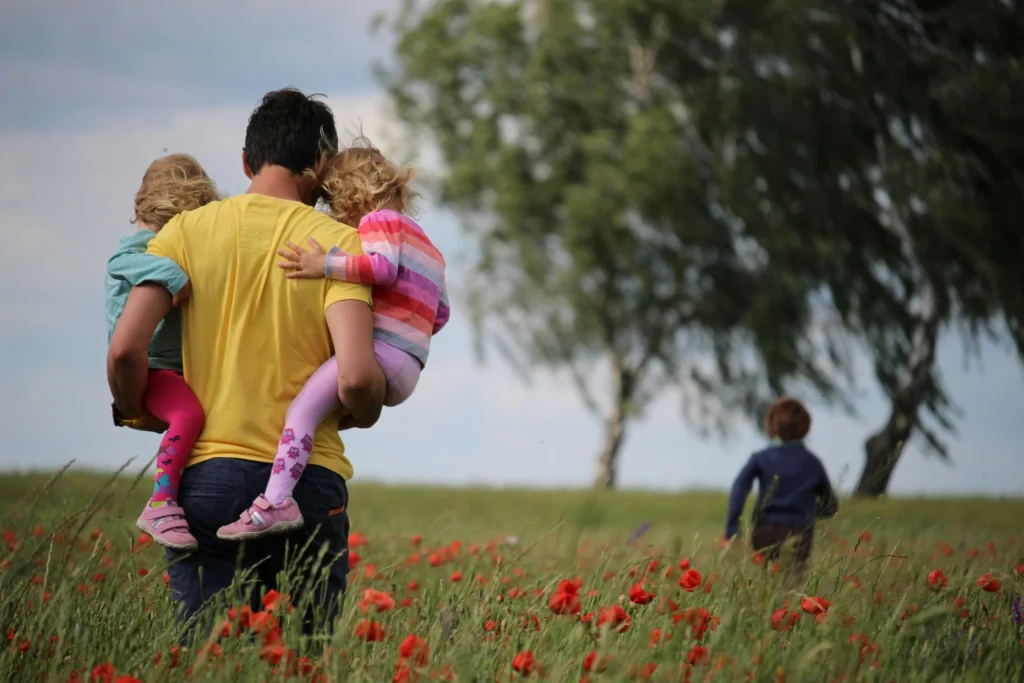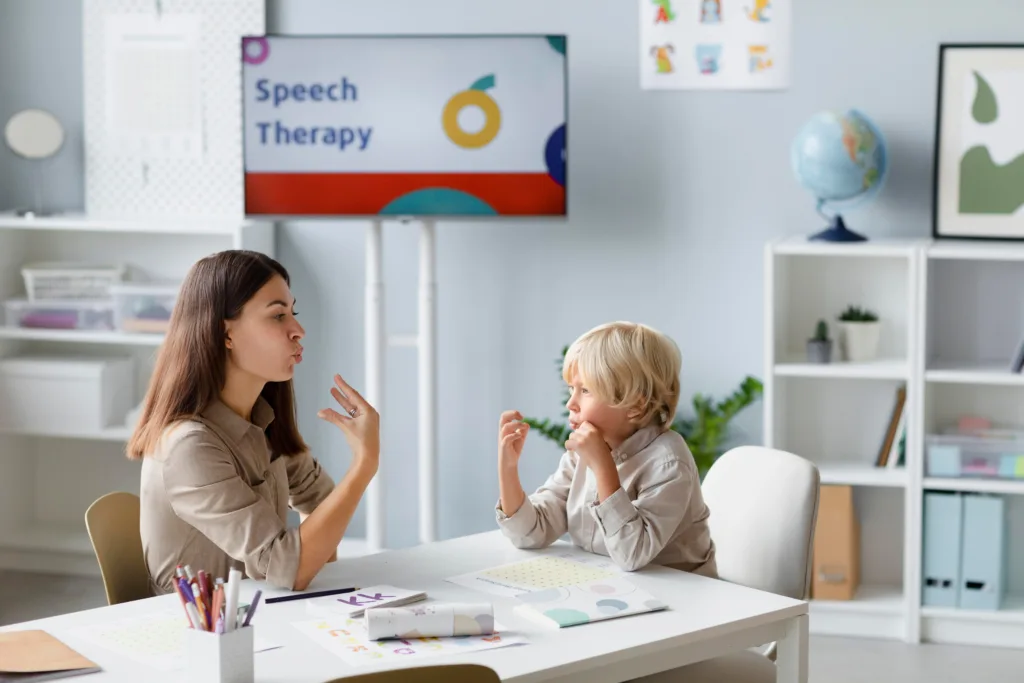Can we teach young minds to master their emotions, or is it an innate ability? As parents and caregivers, we play a significant role in shaping the emotional intelligence of our children.
From birth, kids exhibit basic emotional reactions like crying and frustration. As they grow, they learn to navigate a broader spectrum of emotions. But how can we support them in developing the crucial skill of emotional regulation?
Understanding the complexities of emotional development is key to raising emotionally intelligent kids. By exploring the science behind emotional regulation and implementing practical strategies, we can empower our children to manage their feelings effectively.
Key Takeaways
- Discover the importance of emotional regulation for healthy child development.
- Learn age-appropriate strategies for supporting emotional development.
- Understand the science behind emotional regulation and brain development.
- Identify warning signs of emotional dysregulation in children.
- Explore practical techniques to nurture emotionally intelligent kids.
Understanding Emotional Regulation in Children
Understanding how children regulate their emotions is crucial for their overall development and well-being. Emotional regulation refers to the processes by which we manage, modulate, and modify our emotional responses to various situations. This complex process is essential for children to navigate their emotional landscapes effectively.
What Is Emotional Regulation?
Emotional regulation encompasses the ability to recognize, understand, and manage one’s emotions. It involves being aware of one’s emotional state and having the skills to adjust emotional responses to suit different contexts. When children can effectively regulate their emotions, they are better equipped to handle stress, build strong relationships, and achieve academic success.
Teaching children to identify their emotions provides them with a framework to understand their feelings, making it easier to manage those emotions in socially appropriate ways. This skill is foundational for healthy child development, impacting various aspects of a child’s life, from academic performance to social interactions.
Why Emotional Regulation Matters for Child Development
Emotional regulation is a cornerstone of healthy child development, affecting virtually every aspect of a child’s life. Children who can effectively regulate their emotions show greater resilience when facing challenges and are better equipped to navigate social interactions with peers and adults. Research demonstrates that children with strong emotional regulation skills are more likely to succeed academically, as they can maintain focus and manage frustration during learning tasks.
The ability to understand and manage emotions serves as a protective factor against developing mental health problems like anxiety and depression later in life. Moreover, learning emotional regulation in childhood creates neural pathways that support emotional health throughout adolescence and into adulthood. When children receive validation for their emotional experiences, they develop a stronger sense of self and greater confidence in navigating complex feelings.
Emotional regulation skills provide children with the foundation they need for developing empathy, conflict resolution abilities, and healthy relationship patterns. By teaching children effective emotional regulation strategies, we empower them to lead healthier, more balanced lives. This not only benefits the children but also contributes to a more emotionally intelligent and resilient society.
The Science Behind Emotional Regulation
As we explore the science behind emotional regulation, it becomes clear that brain development plays a pivotal role. Emotional regulation is not just a matter of willpower or upbringing; it is deeply rooted in the neurological development of a child. Understanding this can help parents and caregivers support children more effectively in developing their emotional regulation skills.
Neurological Development and Emotions
Emotional regulation is closely linked to the development of certain brain regions. The neural circuits involved in emotional regulation include areas such as the rostral and subgenual regions of the anterior cingulate, the orbitofrontal, and the dorsomedial prefrontal cortex (PFC). These regions, along with others involved in executive and attentional control like the dorsal anterior cingulate, ventrolateral PFC, and dorsolateral PFC, play a crucial role in how children manage their emotions.
Research has shown that the prefrontal cortex, responsible for executive functions such as planning, decision-making, and impulse control, doesn’t fully mature until early adulthood. This delayed maturation explains why children often struggle with emotional regulation. Brain development follows a bottom-up pattern, where primitive emotional responses develop before the higher-order thinking skills needed to regulate them. As children grow, the connection between the amygdala (emotional center) and the prefrontal cortex strengthens, allowing for improved emotional control over time.
However, factors such as genetic polymorphisms, functional connectivity problems, and stress can impact this development. Chronic stress, in particular, can have long-term consequences on the neural pathways necessary for healthy emotional regulation. On the other hand, consistent, supportive relationships can foster stronger neural connections that support emotional regulation in children.
The Role of Brain Development in Emotional Control
The development of the brain is a critical factor in a child’s ability to control their emotions. As mentioned, the prefrontal cortex and its connection with other brain regions are essential for emotional regulation. Activities such as mindfulness practices and physical exercise have been shown to positively influence brain development in areas related to emotional control. By understanding the timeline of brain development, parents can set realistic expectations for their child’s emotional regulation abilities at different ages.
Repeated experiences of successfully managing emotions with support create stronger neural pathways that facilitate independent emotional regulation over time. This underscores the importance of a supportive environment in helping children develop their emotional regulation skills. As children mature and their brains develop, they become more adept at managing their emotions, thanks to the strengthening connection between emotional and regulatory centers in the brain.
“The connection between the amygdala and the prefrontal cortex is crucial for emotional regulation, and this connection strengthens as children mature.” This process is fundamental to understanding why some children may struggle more than others with emotional regulation. By recognizing the role of brain development, caregivers can tailor their support to meet the individual needs of their children, thereby enhancing their emotional regulation capabilities.
The Developmental Timeline of Emotional Regulation
From infancy through late childhood, the capacity for emotional regulation undergoes significant transformations, reflecting both neurological maturation and environmental influences. As children grow, their ability to manage and regulate their emotions evolves substantially, shaped by their experiences and the environment around them.
Infants (0-1 years): Building the Foundation
During infancy, the foundation for emotional regulation is laid. Infants begin to develop basic regulatory mechanisms, primarily through interactions with their caregivers. Responsive parenting plays a crucial role in helping infants manage their emotions, with soothing techniques and physical touch being essential tools. As infants grow into the latter part of their first year, they start to exhibit early signs of self-soothing, such as sucking on pacifiers or finding comfort in familiar objects.
Toddlers (1-3 years): Emerging Self-Regulation
Toddlers start to assert their independence while still heavily relying on their caregivers for emotional support. This period is marked by the emergence of self-regulation skills, albeit rudimentary. Toddlers begin to use simple strategies like tantrums to express their emotions, and they start to learn basic coping mechanisms. Modeling appropriate behavior is crucial during this phase, as toddlers pick up on the emotional cues of those around them.
Preschoolers (3-5 years): Growing Emotional Vocabulary
Preschoolers experience significant growth in their emotional vocabulary and begin to understand and label their emotions more effectively. They start to develop more sophisticated strategies for managing their feelings, such as verbalizing their emotions and seeking comfort from caregivers. The environment plays a critical role in shaping their emotional regulation skills, with positive reinforcement encouraging healthy emotional expression.
School-Age Children (6-12 years): Developing Strategies
School-age children continue to refine their emotional regulation strategies as their cognitive abilities mature and their social experiences expand. They become increasingly capable of understanding the causes of their emotions and recognizing how their feelings affect their behavior. Key developments during this stage include:
- Employing complex regulation strategies such as cognitive reframing and problem-solving.
- Seeking social support from peers and adults when emotionally challenged.
- Understanding how their emotions affect others and considering multiple perspectives.
- Managing frustration, maintaining focus, and persisting through challenges due to academic demands.
- Developing the ability to anticipate emotional reactions and prepare strategies in advance by late elementary school.
Peer relationships become increasingly important, providing both challenges and opportunities for emotional growth and regulation practice.
Ultimately, helping children manage their emotions begins by validating those emotions and providing an environment in which they feel safe to express them. As several studies have shown, children who feel safe are more likely to develop and use appropriate emotion regulation skills to deal with difficult feelings.
Signs of Healthy Emotional Regulation in Children
Understanding the signs of healthy emotional regulation can help parents and caregivers support children’s emotional growth. As children develop, their ability to manage and regulate emotions is a crucial aspect of their overall well-being. Healthy emotional regulation is not about suppressing emotions but about being able to respond to emotional stimuli in a balanced way.
Age-Appropriate Emotional Responses
Children with healthy emotional regulation exhibit age-appropriate emotional responses. This means their emotional reactions are suitable for their developmental stage. For instance, it’s normal for toddlers to have tantrums due to their limited vocabulary and impulse control, while older children are expected to express their feelings more verbally and manage their impulses better. As children mature, they should demonstrate an increasing ability to use language to describe their feelings and needs, reducing the reliance on aggressive or disruptive behavior.
Moreover, well-regulated children show an understanding of the emotional nuances and can differentiate between various emotional states. They are more likely to express their emotions in a way that is understandable to others, facilitating healthier interactions with peers and adults alike.
- They can verbalize their feelings and needs more effectively as they grow older.
- Their emotional responses become more appropriate to the situation.
- They begin to show empathy towards others, understanding that others can have different emotions and feelings.
Recovery from Emotional Episodes
Another key indicator of healthy emotional regulation is the ability to recover from emotional episodes within a reasonable timeframe. Children who are well-regulated can return to a calm state after being upset, without lingering distress. The recovery process may vary across different developmental stages; older children generally recover more quickly and independently than their younger counterparts.
Well-regulated children also demonstrate an increasing capacity to use self-soothing strategies such as deep breathing, positive self-talk, or seeking appropriate support when needed. The ability to reflect on emotional episodes after they’ve passed is a sign of developing emotional maturity and regulation. Moreover, children with good recovery skills can usually resume normal activities after an emotional moment without the incident negatively affecting their entire day.
- They can bounce back from emotional upsets more quickly.
- They learn from emotional experiences and apply those lessons to future situations.
- They become more adept at accepting comfort and support during emotional recovery, showing secure attachment.
Warning Signs of Emotional Dysregulation
Recognizing the warning signs of emotional dysregulation is crucial for early intervention and support. Children with emotional dysregulation may struggle with managing their emotions, leading to various behavioral, emotional, and physical manifestations.
Behavioral Indicators
Children experiencing emotional dysregulation often display behavioral changes that can be concerning. These may include intense emotional outbursts that seem to arise suddenly and are difficult to manage. Some children may exhibit rapid and intense mood swings, shifting from extreme happiness to deep sadness or anger within short periods. Physical restlessness, such as fidgeting or an inability to remain calm in routine situations, can also be a sign of underlying emotional regulation difficulties.
Other behavioral indicators include persistent negative self-talk or catastrophic thinking patterns. In some cases, children may appear emotionally flat or disconnected as a coping mechanism for overwhelming feelings. Understanding these behaviors as potential signs of emotional dysregulation can help in providing appropriate support.
| Behavioral Indicator | Description |
|---|---|
| Intense Emotional Outbursts | Sudden and difficult to manage emotional episodes. |
| Mood Swings | Rapid shifts between extreme emotional states. |
| Physical Restlessness | Fidgeting or inability to remain calm. |
| Negative Self-Talk | Catastrophic thinking patterns or persistent negative self-talk. |
Emotional and Physical Symptoms
Emotional dysregulation can also manifest through various emotional and physical symptoms. Children may experience heightened anxiety or worry that interferes with their daily functioning. They may report feeling overwhelmed by their emotions or describe feeling like they have no control over how they feel. Sleep disturbances, including difficulty falling asleep or staying asleep, are common among children struggling with emotional regulation.
Physical symptoms such as headaches, stomachaches, or other somatic complaints often accompany emotional dysregulation. These physical manifestations can be a child’s way of expressing emotional distress. Recognizing these signs can help in identifying children who may need additional support in managing their emotions.
| Symptom | Description |
|---|---|
| Heightened Anxiety | Interferes with daily functioning. |
| Feeling Overwhelmed | Lack of control over emotions. |
| Sleep Disturbances | Difficulty falling or staying asleep. |
| Physical Complaints | Headaches, stomachaches, or other somatic complaints. |
The Impact of Emotional Dysregulation on Children's Lives
Children who struggle with emotional dysregulation may face significant difficulties that impact their daily functioning and long-term mental health. Emotional dysregulation is a complex issue that can affect various aspects of a child’s life, from their academic performance to their social relationships and overall mental wellbeing.
Academic Performance
Emotional dysregulation can significantly hinder a child’s ability to succeed academically. When children are unable to manage their emotions, they may struggle to focus, follow instructions, and complete tasks, leading to poor academic performance. Moreover, the stress associated with emotional dysregulation can impair cognitive functioning, further exacerbating academic challenges.
Some of the ways emotional dysregulation affects academic performance include:
- Difficulty in concentrating due to emotional turmoil
- Increased absenteeism due to anxiety or depression
- Impaired problem-solving skills and decision-making abilities
Social Relationships
Emotional dysregulation can also strain a child’s social relationships. Children who are unable to regulate their emotions may have outbursts, become easily irritated, or withdraw from social interactions, making it challenging for them to form and maintain healthy relationships with peers and adults alike.
| Impact on Social Relationships | Consequences |
|---|---|
| Difficulty in empathizing with others | Strained friendships and social isolation |
| Aggressive or withdrawn behavior | Rejection by peers and difficulty in forming new relationships |
| Inconsistent emotional responses | Confusion and frustration among peers and adults |
Mental Health Outcomes
Persistent emotional dysregulation in childhood is associated with an increased risk of developing various mental health conditions, including anxiety disorders and depression. The bidirectional relationship between emotional dysregulation and mental health means that while poor regulation can exacerbate mental health symptoms, existing mental health conditions can also worsen regulation abilities.
Some key mental health outcomes related to emotional dysregulation include:
- Increased vulnerability to stress and trauma
- Development of negative self-beliefs and lowered self-esteem
- Maladaptive coping strategies, such as avoidance or self-harming behaviors
Improving emotional regulation skills can have a positive impact on existing mental health conditions, highlighting the importance of early intervention and targeted support for children struggling with emotional dysregulation.
Creating a Supportive Environment for Emotional Regulation
To help children develop emotional regulation skills, it’s vital to create a supportive and understanding home environment. This involves several key strategies that not only help children manage their emotions more effectively but also foster a positive and nurturing atmosphere for the entire family.
Calm Home Atmosphere
Setting up a calm home atmosphere is foundational to supporting emotional regulation in children. A calm environment can be achieved by ensuring that the physical space is comfortable and clutter-free, promoting relaxation and reducing stress. Using emotion-friendly language and validating children’s feelings helps them understand and manage their emotions better. Additionally, creating a peaceful ambiance through soft lighting, soothing colors, and calming music can significantly impact children’s emotional well-being.
- Designate quiet areas for relaxation and calm activities.
- Minimize exposure to stressful or violent media content.
- Encourage activities that promote relaxation, such as reading or drawing.
Predictable Routines
Establishing predictable routines is another crucial aspect of creating a supportive environment. Routines provide children with a sense of security and stability, helping them navigate their day with more confidence. Regular schedules for meals, homework, and bedtime can significantly reduce anxiety and stress, making it easier for children to regulate their emotions.
- Create a daily schedule that includes time for structured activities and free play.
- Establish consistent bedtime routines to ensure adequate rest.
- Plan regular family time to strengthen bonds and create positive memories.
Safe Spaces for Emotional Expression
Creating safe spaces where children feel comfortable expressing their emotions without fear of judgment is essential. These spaces can be physical areas in the home designated for emotional release or ‘feeling corners’ where children can express their feelings through art, writing, or talking. It’s also important to teach children that while all feelings are valid, not all behaviors are acceptable, helping them learn to express their emotions appropriately.
- Designate a specific area for emotional expression, such as a ‘feelings room’ or a ‘calm-down corner’.
- Encourage the use of art supplies, journals, or other creative outlets for emotional expression.
- Model healthy emotional expression yourself, as children learn significantly from observing their caregivers.
By implementing these strategies, you can create a supportive environment that fosters healthy emotional regulation in children, helping them develop into emotionally intelligent and resilient individuals.
Teaching Children to Identify and Label Emotions
Teaching children to identify and label their emotions is a crucial step in developing their emotional regulation skills. Emotional awareness is the foundation upon which children can build healthy strategies to manage their feelings and behaviors. By helping kids understand and articulate their emotions, we empower them with a vital life skill that benefits their well-being and relationships. As parents and caregivers, you play a significant role in guiding children through this process.
Building an Emotional Vocabulary
Developing an emotional vocabulary is essential for children to express their feelings effectively. You can start by introducing simple emotion words like “happy,” “sad,” “angry,” and “scared.” As children grow, you can expand their vocabulary to include more complex emotions such as “frustrated,” “disappointed,” or “excited.” Using these words in context helps children understand their meanings and applications.
Encourage your children to identify and label their emotions throughout the day. You can do this during daily routines, such as during breakfast or before bedtime, by asking how they are feeling. This practice not only enhances their emotional vocabulary but also helps them develop a habit of acknowledging and expressing their emotions.
- Use everyday situations to discuss emotions and help children connect feelings to specific contexts.
- Encourage children to notice and name emotions in others, such as family members or characters in books.
Using Visual Aids and Emotion Charts
Visual aids like emotion charts can be powerful tools in teaching children to identify and label their emotions. These charts typically display various facial expressions associated with different emotional states. By referencing these charts, children can learn to recognize and articulate their feelings more effectively.
You can place emotion charts in visible locations around the house, such as the living room or child’s bedroom, to serve as constant reminders. Additionally, using mirrors to make facial expressions associated with different emotions can help children connect their internal feelings with external expressions.
Practicing Emotion Recognition in Daily Life
Practicing emotion recognition in daily life helps children develop their emotional awareness in real-world contexts. Engage your children in activities like “emotion detective,” where they guess how others might feel in various situations. This game not only develops perspective-taking but also enhances emotional awareness.
Reflecting on emotional experiences after they’ve passed is another effective strategy. It helps children recognize patterns in their emotional responses and builds skills that can be accessed during more emotionally challenging moments.
Practical Strategies for Developing Emotional Regulation Skills in Children
Helping children develop emotional regulation skills is one of the most important things parents and caregivers can do to support their long-term mental health. Emotional regulation is not just about managing emotions; it’s about teaching children the skills they need to navigate life’s challenges effectively. In this section, we will explore practical strategies that can help children develop these essential skills.
Breathing Techniques and Body Awareness
Teaching children breathing techniques is a simple yet effective way to help them regulate their emotions. Deep breathing can calm the nervous system and reduce stress. You can practice deep breathing exercises with your child, such as blowing bubbles or using a pinwheel to visualize the breath. Body awareness activities, like yoga or progressive muscle relaxation, can also help children tune into their physical sensations and manage their emotional responses.
Mindfulness Practices for Children
Mindfulness practices can help children become more aware of their thoughts, feelings, and bodily sensations. Simple mindfulness exercises, such as paying attention to the breath or noticing the sensations in their feet on the ground, can be adapted for children. Mindfulness can be practiced through guided meditations, mindful walking, or even mindful eating. These practices help children develop a greater sense of self-awareness and improve their ability to regulate their emotions.
Physical Activities that Support Emotional Regulation
Physical activity is a powerful tool for emotional regulation. Exercise can help reduce stress and anxiety by releasing endorphins, which are natural mood lifters. Activities like running, dancing, or playing sports can be particularly effective. Additionally, activities that combine physical movement with mindfulness, such as tai chi or certain forms of yoga, can enhance emotional regulation by promoting both physical and mental well-being.
Creative Expression Through Art and Play
Creative expression is a valuable outlet for children’s emotions. Activities like drawing, painting, or sculpting allow children to express their feelings in a healthy and constructive way. Play, whether imaginative or structured, also provides an opportunity for children to process their emotions and develop problem-solving skills. Encouraging creative expression can help children communicate their feelings more effectively and regulate their emotional responses.
Problem-Solving and Decision-Making Skills
Teaching children problem-solving and decision-making skills is crucial for emotional regulation. By learning a structured problem-solving process, children can approach emotional challenges with a clear mind rather than reacting impulsively. Strategies like generating multiple solutions, using decision-making frameworks, and breaking down problems into manageable steps can empower children to handle challenges more effectively. Role-playing different scenarios and celebrating successful problem-solving can further reinforce these skills.
- Teaching children a structured problem-solving process helps them approach emotional challenges with cognitive tools rather than reactive responses.
- The ability to generate multiple solutions to problems supports flexible thinking and reduces emotional rigidity.
- Decision-making frameworks like pros and cons lists or decision trees help children make choices when emotions might otherwise cloud judgment.
- Collaborative problem-solving approaches that involve children in finding solutions build both skills and emotional buy-in.
The Zones of Regulation Approach
Emotional regulation is a crucial life skill, and the Zones of Regulation approach offers a structured method to teach it to children. This framework is designed to help children understand and manage their emotions more effectively, leading to improved self-regulation and overall well-being.
Understanding the Four Zones
The Zones of Regulation framework categorizes emotional states into four zones: the Blue Zone, the Green Zone, the Yellow Zone, and the Red Zone. Each zone represents different levels of emotional arousal and regulation. The Blue Zone is associated with low states of alertness and energy, often characterized by feelings of sadness, tiredness, or boredom. The Green Zone represents a regulated state, where children are calm, focused, and ready to learn. The Yellow Zone indicates a heightened state of alertness, which can manifest as anxiety, frustration, or excitement. The Red Zone is characterized by extremely high levels of emotional arousal, often resulting in intense anger, explosive behavior, or panic.
Understanding these zones helps children identify their emotional states and develop strategies to regulate their emotions effectively. By teaching children to recognize which zone they are in, parents and caregivers can provide targeted support to help them manage their emotions.
Implementing Zones of Regulation at Home
Implementing the Zones of Regulation at home involves several strategies that help children develop emotional regulation skills. First, it’s essential to teach children to identify which zone they’re in through regular check-ins and visual supports. Creating a family “tools” poster that lists strategies for returning to the Green Zone can help children develop personalized regulation approaches.
Other effective strategies include modeling zone identification by labeling your own emotional states, using consistent language across home and school settings, and incorporating zone check-ins during daily routines. Creating a calm-down corner with visual reminders of the zones and regulation strategies provides a supportive space for emotional regulation. Teaching children that different strategies work for different zones helps them develop targeted approaches to regulation.
Celebrating when children successfully identify their zone or use a regulation strategy reinforces these important skills. Involving the whole family in using the Zones framework creates a shared emotional language and normalizes regulation as a lifelong skill.
Age-Specific Techniques for Supporting Emotional Regulation
Supporting children’s emotional regulation involves understanding and implementing strategies that are appropriate for their age group. As children develop physically, cognitively, and emotionally, their needs for emotional regulation change. Therefore, it’s crucial for parents, educators, and caregivers to adapt their approaches to meet these evolving needs.
Techniques for Toddlers and Preschoolers
For toddlers and preschoolers, emotional regulation is primarily supported through external means, as they are still developing their internal regulatory mechanisms. Predictable routines and a calm environment help these young children feel secure and reduce emotional overwhelm.
- Labeling and validating their emotions helps them develop an emotional vocabulary.
- Simple breathing exercises or physical activities like dancing or clapping can help regulate their emotions.
- Using visual aids like emotion charts can assist in teaching them to identify and express their feelings.
These early years are foundational for later emotional regulation skills, making consistent and supportive parenting crucial.
Strategies for Elementary School Children
Elementary school children are at a stage where they can begin to internalize emotional regulation strategies. They can benefit from learning mindfulness practices and being encouraged to express their feelings through art or writing.
- Teaching them to recognize and label their emotions continues to be important.
- Encouraging physical activity as a way to manage stress and emotions.
- Introducing simple problem-solving strategies to help them manage situations that trigger strong emotions.
By supporting their growing independence and teaching them to apply emotional regulation strategies in various contexts, we help them become more resilient.
Approaches for Adolescents
Adolescents are in a phase of significant emotional, social, and cognitive development. They benefit from understanding the neuroscience behind emotions and regulation, which can help normalize their experiences. Digital tools like emotion tracking apps can be particularly appealing and effective.
- Peer-based approaches can be very effective, as adolescents are highly influenced by their peers.
- Teaching them to identify their personal values can help guide their emotion-regulation choices.
- Mindfulness and meditation practices can support them in developing a non-judgmental awareness of their emotions.
- Encouraging physical outlets like sports or dance provides healthy channels for their emotions.
By engaging adolescents in discussions about their emotional regulation and involving them in the process of finding strategies that work for them, we can support their development of healthy emotional management skills.
The Parent's Role in Modeling Emotional Regulation
Children learn how to manage their emotions largely by observing how their parents handle theirs, making it essential for parents to model healthy emotional regulation. As a parent, your emotional responses and coping strategies serve as a powerful teaching tool for your child. By demonstrating effective emotional regulation, you can help your child develop the skills they need to navigate life’s challenges with confidence and resilience.
Managing Your Own Emotions Effectively
Managing your own emotions is crucial when it comes to modeling healthy emotional regulation for your child. When you effectively regulate your emotions, you create a safe and stable environment for your child to learn and grow. To achieve this, it’s essential to recognize your emotional triggers and develop strategies to manage them. For instance, if you know that traffic jams trigger frustration in you, you can prepare by listening to calming music or practicing deep breathing exercises before and during your commute.
One effective way to manage your emotions is by practicing self-awareness. This involves recognizing your emotional state and understanding what triggers certain emotions. By being more aware of your emotions, you can take proactive steps to manage them before they escalate. For example, if you notice that you’re starting to feel angry, you can take a step back, breathe, and choose a more constructive way to respond.
| Emotion | Trigger | Management Strategy |
|---|---|---|
| Frustration | Traffic jams | Deep breathing, calming music |
| Anger | Conflict | Take a step back, count to 10 |
| Anxiety | Uncertainty | Prepare for the worst-case scenario, focus on what you can control |
Demonstrating Healthy Coping Strategies
Demonstrating healthy coping strategies is another critical aspect of modeling emotional regulation for your child. By showing your child how you manage stress and negative emotions, you can help them develop their own coping mechanisms. There are several ways to do this, including:
- Explicitly naming the coping strategies you use, such as “I’m feeling overwhelmed, so I’m going to take a break.”
- Demonstrating a variety of coping techniques, such as exercise, creative expression, or talking with a friend.
- Using healthy emotional outlets like journaling, meditation, or spending time in nature.
- Showing your child how to take breaks when needed, demonstrating proactive regulation before emotions become overwhelming.
- Practicing and modeling positive self-talk, helping your child develop their own constructive internal dialogue.
As the renowned psychologist Dr. Dan Siegel once said, “The way we regulate our own emotions has a profound impact on our children’s ability to regulate theirs.” By modeling healthy emotional regulation and demonstrating effective coping strategies, you can help your child develop the skills they need to thrive in life.
“The most important thing parents can do for their children is to model the behavior they want their children to exhibit.”
— Dr. Laura Markham, Parenting Coach
Responding to Emotional Outbursts and Meltdowns
Responding to children’s emotional meltdowns requires a thoughtful and compassionate strategy. When children experience intense emotions, they need guidance on how to manage their feelings and return to a state of calm. As caregivers, our response to these outbursts can significantly impact a child’s emotional development and ability to regulate their emotions effectively.
De-escalation Techniques
De-escalating an emotional outburst involves creating a safe and supportive environment that helps the child calm down. One effective technique is to remain calm and composed, as children often mirror the emotional state of the adults around them. Using a calm tone and gentle language can help to reduce the child’s distress. It’s also important to provide physical comfort when appropriate, such as offering a hug or holding the child’s hand, but respecting their personal boundaries is crucial.
Another valuable de-escalation technique is teaching children to recognize and label their emotions. By acknowledging their feelings and validating their experience, you can help them begin to calm down. Encouraging deep breathing exercises or other relaxation techniques can also be beneficial. For some children, having a visual reminder of these strategies, such as a feelings chart, can be particularly helpful.
| De-escalation Technique | Description | Benefits |
|---|---|---|
| Remaining Calm | Caregivers stay calm and composed | Reduces child’s distress, promotes calm environment |
| Emotion Labeling | Acknowledging and validating child’s feelings | Helps child recognize and manage emotions |
| Deep Breathing Exercises | Encouraging slow, deep breaths | Calms the child, reduces stress |
Supporting Recovery After Emotional Episodes
After an emotional outburst has passed, it’s essential to support the child’s recovery. This involves creating a calm and comforting environment that allows the child to feel safe and relaxed. Sometimes, simply being present with the child in silence can be incredibly comforting. Other times, engaging in a calming activity together, such as reading a book or doing a quiet puzzle, can help to soothe the child.
It’s also important to reflect on the emotional episode after the child has fully recovered. Using a curious and non-judgmental approach, you can discuss what happened and how the child felt. This reflection can help the child develop insight into their emotional patterns and triggers, empowering them with the knowledge to better manage their emotions in the future.
Key Strategies for Supporting Recovery:
- Creating a calm environment
- Engaging in comforting activities together
- Reflecting on the emotional episode
Learning from Emotional Challenges
Emotional outbursts and meltdowns can be valuable learning opportunities for children. By collaboratively developing plans for handling similar situations in the future, you can empower children with concrete strategies for managing their emotions. Celebrating small improvements in emotional regulation can also build confidence and reinforce progress.
Additionally, using stories or examples of others’ emotional challenges can help normalize the universal nature of emotional learning. Framing emotional regulation as a lifelong skill that everyone continues to develop can help children view challenges as opportunities for growth rather than failures.
By adopting a growth mindset towards emotional regulation, children can develop resilience and a deeper understanding of their emotional experiences.
When to Seek Professional Help
Knowing when to seek outside help for your child’s emotional regulation challenges can be a game-changer. As a parent or caregiver, you’re often the first to notice when your child is struggling with managing their emotions. While it’s normal for children to experience emotional dysregulation at times, persistent or severe difficulties may indicate the need for professional support.
Signs That Additional Support Is Needed
If your child is consistently having trouble regulating their emotions, it may be time to seek additional help. Some signs that your child might benefit from professional support include:
- Frequent, intense emotional outbursts that are difficult to calm
- Difficulty recovering from emotional episodes
- Emotional struggles that interfere with daily life, such as school or social activities
- Significant changes in behavior, appetite, or sleep patterns
- Expressions of hopelessness, worthlessness, or persistent sadness
These signs suggest that your child might benefit from the expertise of a mental health professional who specializes in working with children.
Types of Professional Support Available
Various professionals can provide support for children struggling with emotional regulation. These include:
| Professional | Specialization | Approach |
|---|---|---|
| Child Psychologists | Understanding children’s emotional development | Assessment and evidence-based interventions |
| Child Psychiatrists | Evaluating the need for medication | Combining therapy with medication when necessary |
| Play Therapists | Helping younger children process emotions | Play-based approaches for emotional regulation |
| Occupational Therapists | Addressing sensory processing differences | Sensory integration techniques |
Additionally, therapy approaches like Dialectical Behavior Therapy (DBT) and Cognitive Behavioral Therapy (CBT) can be highly effective in teaching children emotional regulation skills. Seeking the right type of professional support can significantly improve your child’s emotional health and overall well-being.
Emotional Regulation and Special Considerations
Children with specific challenges, such as ADHD, anxiety, or trauma, need tailored approaches to develop emotional regulation skills. Emotional regulation is crucial for children’s overall development and well-being.
Supporting Children with ADHD
Children with ADHD often struggle with impulsivity and inattention, which can affect their emotional regulation. Strategies such as breaking tasks into smaller steps, using positive reinforcement, and teaching self-control techniques can be helpful. For instance, using a visual timer can help a child with ADHD stay on task and manage transitions more effectively.
- Breaking tasks into smaller, manageable steps
- Using positive reinforcement to encourage good behavior
- Teaching self-control techniques, such as deep breathing
Helping Children with Anxiety or Depression
Anxiety and depression can significantly impact a child’s ability to regulate their emotions. Techniques such as cognitive-behavioral therapy (CBT), mindfulness practices, and creating a safe space for emotional expression can support these children. Encouraging open communication about their feelings and validating their emotions can also be beneficial.
- Cognitive-behavioral therapy (CBT) to address negative thought patterns
- Mindfulness practices to reduce stress and anxiety
- Creating a safe space for emotional expression
Trauma and Emotional Regulation
Trauma can profoundly affect a child’s emotional regulation capabilities. Understanding the impact of trauma on the developing brain and using trauma-informed approaches can help support these children. Key considerations include establishing safety and predictability, using sensory-based regulation strategies, and providing co-regulation with consistent adults.
- Establishing safety and predictability in the environment
- Using sensory-based regulation strategies, such as play therapy
- Providing co-regulation with consistent, supportive adults
By understanding the unique needs of children with different challenges and using tailored approaches, we can support their emotional regulation development and overall well-being.
Conclusion
Developing emotional regulation skills in children is a multifaceted process that requires patience, understanding, and consistent support. As parents and caregivers, you play a crucial role in helping children navigate their emotional landscape. The journey begins in infancy and continues throughout childhood, with each developmental stage presenting new opportunities and challenges.
Creating an environment that supports emotional awareness and expression is vital. By doing so, you provide children with the safety they need to develop and practice regulation skills. Different approaches, such as the Zones of Regulation framework, offer structured ways to help children understand and manage their emotional states. This framework, along with other strategies like breathing techniques, mindfulness practices, and physical activities, can be tailored to suit the needs of children at various developmental stages.
It’s essential to recognize that children develop at their own pace. While some may quickly grasp emotional regulation skills, others may need more time and support. For children with special considerations, such as ADHD, anxiety, or trauma histories, tailored approaches may be necessary to address their specific needs effectively.
The skills children develop through emotional regulation lay the foundation for their emotional health, resilience, and relationship success throughout life. By investing in their emotional regulation development, you are equipping them with essential tools for navigating life’s challenges with confidence and adaptability.
Remember, emotional regulation is a lifelong skill that continues to evolve throughout adulthood. The goal is not perfection but rather growth and an increasing capacity for emotional awareness and management. As you support your child’s emotional regulation development, you are not only enhancing their current well-being but also setting them up for long-term success.
In conclusion, the development of emotional regulation skills in children is a critical aspect of their overall development, impacting various areas of their lives. By understanding the importance of emotional regulation, creating supportive environments, and teaching specific regulation strategies, you can significantly influence your child’s ability to manage their emotions effectively. As you continue on this journey, remember that your role as a parent or caregiver is pivotal in shaping your child’s emotional future.








